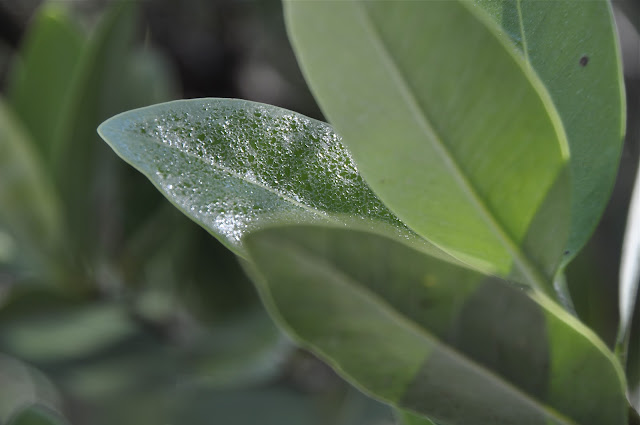The first photo is of breathing tubes for Black Mangroves. Mangroves (black, red and white occupy this area) are essential to the area. They:
- Provide the base of the food-web.
- Filter water from the Indian River Estuary.
- Provide a nursery habitat for fish and invertebrates.
- Provide habitat for birds, mammals and other wildlife.
Because this area has brackish water (salt and fresh), the mangroves have adapted and secrete the salt through the pores of their leaves - ultimately leaving salt crystals behind.
Small yellow leaves give way to long seeds, which drop and float around till they take root.
~ A single strand of Spanish Moss ~
~ Millions of small fish inhabit the swampy areas ~
Airborne - somethings!
Three hurricanes, between 2004 and 2005, topped off many of the weaker palm trees. In an effort to keep things as ecologically normal as possible, the center has not removed these - but rather allow them to remain and to be repurposed into habitat for other animals.
~ Osprey ~
~ Anhinga with fish ~
~ Contractor who seeds clam larva for future use ~
~ Oyster shells from restaurants are collected and ultimately placed in the Indian River Inlet and seeded with oyster larva ~
On to the self-contained, saltwater lagoon. Sea-life that occupy this lagoon come from animals accidentally caught offshore and brought here. They are fed here, and therefore do not hunt one-another. Currently, the lagoon is experiencing algae bloom due to warmer than usual temperatures earlier in the season. As a result - the lagoon's water is murky. It made for interesting pictures - between the murkiness, the reflection of the sky, the fact that most of my pictures are taken from the boardwalk above, and the layers of fish - some of the pictures look surreal. I can tell you that we have sting-rays and nurse sharks. That's about it!
 |
| Dorsal fin of nurse shark |
If you are ever in the neighborhood ......























This is wonderful! Thanks for all your work to put this post together. I have a new appreciation for mangroves. I especially love your last two photos. Incredible.
ReplyDeleteThanks T.! The last two are my favorites as well - sharks swimming in a green sky.
Delete